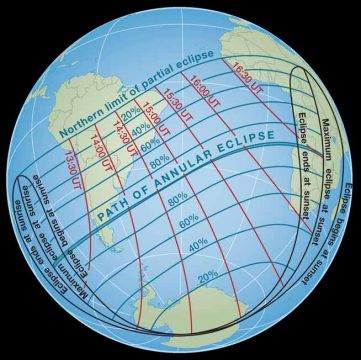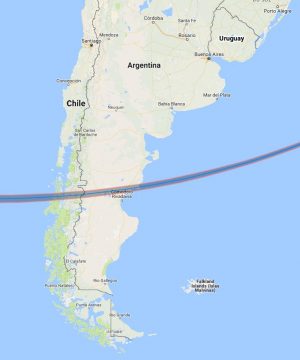Die-hard eclipse chasers have journeyed to the Southern Hemisphere to catch a short and dramatically thin "ring" eclipse of the Sun.

This month's annular solar eclipse is a far-southern event. Red lines show the moment of mid-eclipse in Universal Time; blue lines show the maximum fraction of the Sun's diameter covered by the Moon.
Sky & Telescope diagram; source: Fred Espenak
Whenever the Moon passes directly in front of the Sun, termed a central solar eclipse, we Earthlings usually conjure up visions of the awe and spectacle of totality.
But that's not always the case. The orbital geometry of the Earth-Moon system is subtle. At this time of year, Earth is relatively close to the Sun in its not-quite-circular obit, so the solar disk appears larger than average. And this coming weekend's new Moon is about midway between its perigee on February 18th and its apogee on March 3rd — so its disk won't be particularly large.
The upshot is that when the Moon and Sun meet in the sky on Sunday, February 26th, the result will be an annular or ring eclipse of the Sun. Astronomers calculate that the magnitude of this eclipse — the ratio of the Moon's apparent diameter to the Sun's — is 0.9922. So this event will be very nearly total and only barely annular. It'll be a dramatic sight along the centerline, as the ring at mid-eclipse will be no more than about 15 arcseconds wide!
This geometry also means that the path of annularity — called the antumbra — is very narrow, 31 km (19 miles) wide at the point of greatest eclipse though flaring to as much as 96 km (60 miles) at the endpoints. The culminating ring in this 3¼-hour-long event will last for at most 44 seconds.

Many eclipse-chasers are traveling to southern Argentina, where the prospects for clear skies on eclipse day are most favorable.
Xavier Jubier
The eclipse will be confined almost entirely to the Southern Hemisphere. The path of annularity crosses parts of southern Chile and Argentina, the South Atlantic Ocean (where mid-eclipse occurs at 14:53 Universal Time), Angola, and (at sunset) the Zambia-Congo border.
Partial phases sweep over most of South America, Africa, and Antarctica, as the globe above shows. North Americans are left out entirely.
According to meteorologist Jay Anderson, the weather prospects in Africa are relatively poor. But they're much better in South America and especially over the flat Patagonian plains of southern Argentina, where the likelihood of a cloud-free morning is 60% or better. Not surprisingly, that's where most eclipse-chasers are headed.
So wish them all clear skies — and let's hope they take plenty of dramatic images of this celestial treat.
Check out Fred Espenak's website for more details.
Quelle: Sky&Telescope
---
Rare "ring of fire" solar eclipse to give sky gazers a special treat Sunday

The sky will be illuminated in a “ring of fire” Sunday as the Earth welcomes its first solar eclipse of 2017.
An annular eclipse -- which occurs when the moon casts its shadow on the Earth’s surface, will mainly be visible above parts of the Southern Hemisphere, including Chile, Argentina and Angola, according to NASA.
“An annular eclipse is the product of almost the same celestial geometry as a total solar eclipse -- that is, from the perspective of some place on Earth, the moon crosses in front of the sun’s center,” NASA explained in a blog.
During any type of solar eclipse, the sun, moon, and Earth line up. But an annual eclipse is different. The moon is too far from Earth to obscure the sun completely, leaving the sun’s edges exposed, thus creating that “ring of fire” effect.
Sky lovers who live in the Southern Hemisphere or near the equator can find an interactive map from NASA to search for partial eclipse times. If you live in North America, don’t worry, you’ll have a chance to catch another rare eclipse later this year.
On Aug. 21, less than six months from now, a total solar eclipse will cross the U.S. for the first time in nearly 40 years.
“The path of totality for the August eclipse runs from coast to coast,” NASA says.
During the total solar eclipse, the moon will completely cover the sun.
Either way, if you plan to watch any solar eclipse, NASA officials warn viewers to use protective eyeware.
“Any time part, or all, of the sun’s surface is exposed – whether during an annular eclipse, a partial eclipse, or just a regular day -- it’s essential to use a proper solar filter or an indirect viewing method to view the sun,” NASA warns. “You can never look directly at the sun, and an annular eclipse is no exception!”
Quelle: CBSN
-
ANNULAR SOLAR ECLIPSE: Something strange is about to happen to sunbeams in the southern hemisphere. On Sunday, Feb. 26th, the Moon will pass in front of the sun, covering as much as 99% of the solar disk. It's an annular solar eclipse, shown here in an animation from ShadowandSubstance.com:
Annular eclipses occur when the Moon passes dead center in front of the sun, but does not completely cover it. At maximum eclipse, an intense "ring of fire" surrounds the mountainous limb of the Moon.
The narrow path of annularity snakes across five countries: Chile and Argentina in South America; Angola, the Democratic Republic of the Congo, and Zambia in Africa. People in those countries can see the ring of fire for almost a minute and a half. Outside that path, the eclipse will be partial. This means the sun will turn into a crescent—a slender one near the path of annularity and a fatter one away from it. Caution: Always use safe solar filters to observe the sun.
Observers in the eclipse zone are encouraged to look down as well--for instance, at the sun-dappled ground beneath leafy trees. The sight of a thousand crescent-shaped sunbeams swaying back and forth on a grassy lawn or sidewalk is unforgettable.
Quelle: Spaceweather
-
Update: 26.02.2017
-
LIVE-Frams von SoFi / 14.30 MEZ



...




---
On Feb. 26, a “ring of fire” will be visible in the sky above parts of the Southern Hemisphere, including Chile, Argentina and Angola. This is called an annular eclipse.

Quelle: NASA
